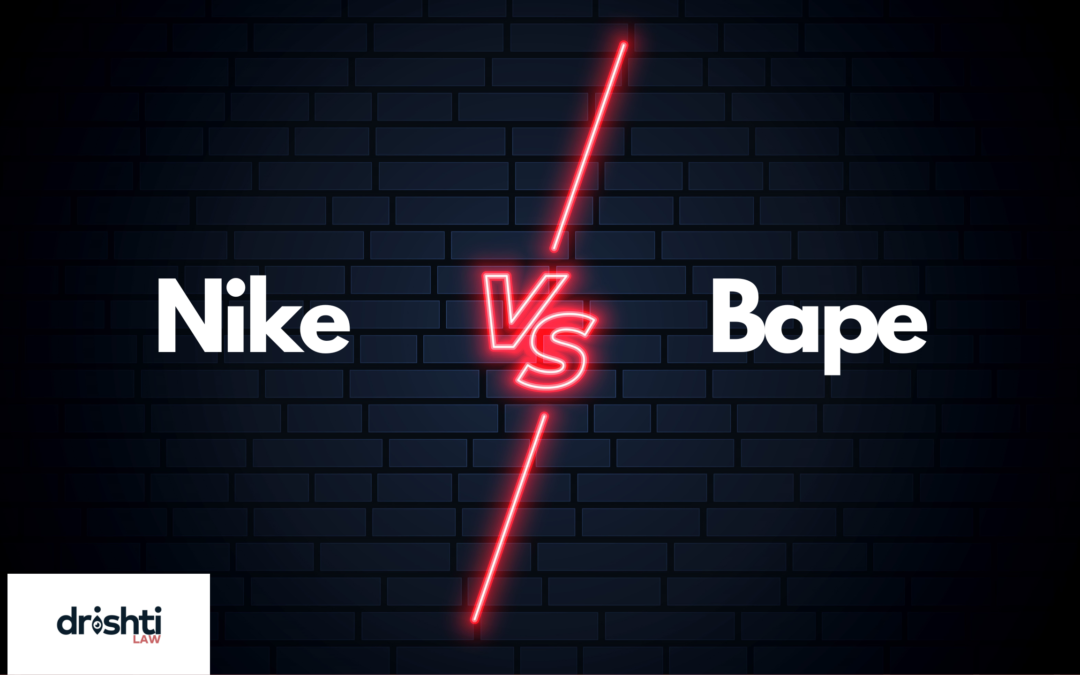A trademark infringement lawsuit has been more appealing to global brands recently. Nike itself has been very aggressive, be it the case against a popular reseller, Stock X, or now against BAPE, a fashion brand founded in Japan in 1993.
This case will impact the creative and sneaker industry immensely, so let’s dig deep into why NIKE has decided to go after BAPE and how brand owners can avoid trademark infringement lawsuits in the future.
What is Trademark Infringement?
Let’s begin with the basics.
Trademark infringement can occur under circumstances where:
- There is an unauthorized use of a brand owner’s trademark, or
- Using a mark similar to the brand owner’s reaches the bar of the likelihood of confusion in the marketplace.
Although the list is not exhaustive but covers the most common ways a trademark infringement lawsuit can be brought against infringing products or services.
NIKE’s Trademarked Designs Vs. The BAPE STA Line
BAPE (A Bathing Ape) was initially founded in Japan by Tomoaki Nagao (“Nigo”) but has since been purchased by a Hong Kong fashion conglomerate. It has been a stronghold in the streetwear community since its inception in 1993. A large part of BAPE’s visibility in the US is due to collaborations they have made with brands, artists, and celebrities. Collaborations are possible through licensing agreements that involve a hefty trademark portfolio on both sides.
BAPE’s current footwear business revolves around implementing its creative vision on the sneakers of major sneaker brands. Even in the past, the company has taken liberally from NIKE by putting its spin on the famous swoosh symbol. As reported, BAPE’s shoe Bape Sta “conspicuously riffed on the Nike Air Force 1.” Additionally, BAPE has taken significant inspiration from Nike’s Dunk Low and Jordan 1s while developing the Sk8 Sta and Court Sta.
NIKE claims that a consumer could be confused that BAPE’s infringing footwear was an authorized use of NIKE’s famous trademark designs—additionally, the repeated use of designs similar to NIKE’s registered trademarks. The repeated use could lead to the dilution of Nike’s rights around their famous marks. NIKE considers BAPE’s alleged copying of its famous shoe designs a significant danger to its footwear business.
As a reminder, your brand is only as strong as its enforcement, and the existence of similar brands that go unchecked reduces the strength of enforcement.
Copying NIKE’s Iconic Designs? You be the Judge:
Why Did Nike Move to Sue BAPE Now?
Consumers and Intellectual Property professionals have always wondered why NIKE never came after BAPE in the past. This is why this lawsuit comes somewhat as a surprise to people in the industry, as the two brands have coexisted without a legal battle. The current filing claims NIKE believes that BAPE “verbatim copies” the famous silhouettes of NIKE shoe designs.
According to NIKE, in the past, BAPE’s infringement was considered inconsistent and de minimis. NIKE didn’t perceive BAPE as a significant enough threat. However, according to NIKE, that changed because BAPE’s infringements have spiked.
Nike’s in-house counsel and lawyers claim that BAPE drastically increased copying Nike’s iconic designs while developing their footwear business in recent years. NIKE also claims that BAPE’s alleged trademark infringements have always been unacceptable but have only recently grown to the level of jumpstarting NIKE into action.
Although, I wonder if Nike’s lawyers could have significantly mitigated BAPE’s alleged infringement in the past if they had acted sooner.
The Impact of the Lawsuit on BAPE & The Streetwear Industry as a Whole
Nike’s trademark infringement lawsuit will significantly impact the footwear industry. For a shoe designer, the level of artistic freedom when developing new designs will be substantially limited. So what does this mean for resellers and shoe designer boutiques nationwide? The suit reads that consumers will confuse BAPE’s alleged infringement as a use that NIKE authorized.
But as we just learned in the Thom Browne v Adidas case, a mark can look similar and still be distinct enough that it has created its own separate market. Similarly, I expect BAPE to argue that a consumer looking for a BAPE sta will not confuse that NIKE endorses it. BAPE has a cult-like following: consumers spend hours in line to buy a pair of shoes because they “had a certain sauce you couldn’t get from a Nike sneaker.”
But, if the court finds in favor of NIKE, BAPE could be looking at significant damages. It is generally believed that BAPE draws inspiration from famous brands when developing its products. A result in NIKE’s favor would force them, and independent shoe designers, to rethink their business model.
How Can Companies Protect Their Trademark Rights?
Companies, boutiques, and designers in the shoe industry can protect their trademark rights by:
- Trademark search & clearance for current and new products to avoid infringement,
- Trademark registration in the appropriate USPTO classes to establish protection, and
- Trademark monitoring and policing to enforce the rights associated with a registered trademark.
If you have a particular design or brand identity that deserves trademark protection, please consult a trademark attorney. When working with a trademark attorney, the chances of registering your trademark at the United States Patent and Trademark Office (USPTO) are significantly increased. More importantly, a brand owner should work with a trademark attorney to enforce a cohesive brand protection strategy.

Sahil Malhotra
Sahil Malhotra is an Intellectual Property Attorney, who founded Drishti (“vision”) law because of his vision in protecting dreams and ideas.
He provided individuals and small businesses with an opportunity to enhance their IP’s value by helping them register trademarks and successfully argue against office actions. In addition to his training and experience, he has been deeply involved in the multifaceted IP portfolio at UIC and continues to be associated with IP organizations and conferences.
To know more about Sahil Malhotra — Click Here
You may follow Sahil Malhotra on Facebook: Sahil Malhotra and on Instagram: @Sahil Malhotra

